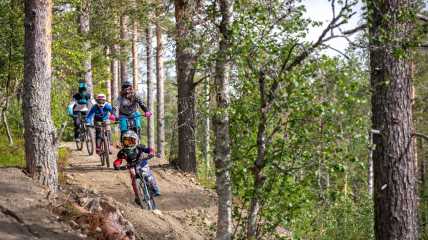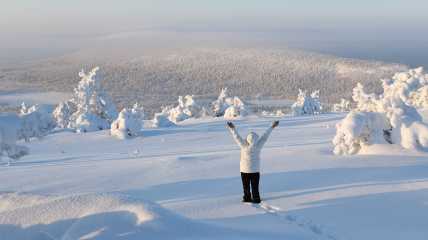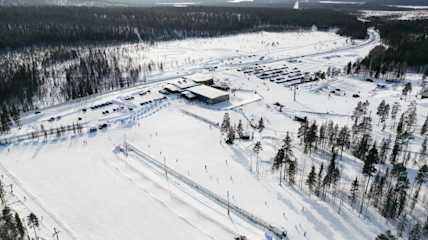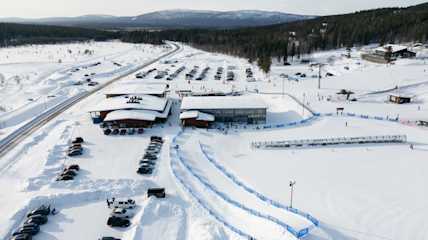
Ski instructor's tips for children starting alpine skiing
For the first time on a slope with the youngest in the family, but how do you get started in practice? You can start skiing at any age, and the lessons for the basics of alpine skiing are for everyone.
However, teaching your own child to ski can be challenging for many parents, and teaching requires patience and perseverance. The best way to get into the secrets of downhill skiing is with the guidance of a skilled ski instructor, but you can also practice on your own. We gathered together a few easy tips for parents from a ski instructor, on how to work on a slope with a child for the first time.
GET TO KNOW THE GEAR IN ADVANCE
When going on the slopes for the first time with the youngest members of the family, it is important to familiarize yourself with the equipment well in advance. If your child has their own skis, it's a good idea to get to know the gear already at home. However, it is not necessary for a child to have their own equipment, because as children grow up, their use the gear often a short time. Ski resort's Zero Point and South Point Rentals almost always have a good selection of equipment for the little ones in the family as well, so it’s worth considering whether it would be more sensible to rent equipment for the child. Levi Ski Resort, for example, has two large rental shops with equipment for even small children. Rental professionals are also happy to provide guidance on the selection and use of equipment.
SLOWLY TO THE SLOPE
Many parents often take children who are going skiing for the first time directly with the lift to the top of the children’s slope, even though basic skills have not yet been practiced at
all. However, it is a good idea to get to know the skis, how to use them, and especially to fall safely on flat ground at first. Heavy boots and skis, as well as helmets, may seem strange to many children at first. At Levi Ski School, the first lessons always start on flat ground, where basic skills such as safe falling, getting up with the skis, and stopping are practiced. Ski school instructors have a lot of fun games to practice on flat ground which helps to learn different skills.

FROM FLAT GROUND PRACTICES TO THE SLOPE
A safe fall is one of the most important skills to learn right from the start. When learning to ski or snowboard, almost everyone falls at the beginning and it’s good to remember that a fall is not the end of the world! While falling, never put your hands first to the ground, as your wrists may break easily if they crash into the ground or when you have the entire body weight taken by your hands. In a safe fall, your hands are close to your own body, like in a hugging position, and when you fall, you go as low as possible and fall on your side in a controlled way. After a crash, getting up in a controlled way is just as important. It is important for a child to be able to get up and act correctly, for example when falling in a lift. When getting up, the skis should always be sideways to the slope and the tips of the skis should point in the same direction. This way, the skis will not slip from under until the child gets back upright.
Once the falling and getting up are in place, it’s time to move on to practice moving on with skis. An easy way to start is to practice gliding on the snow only with one ski. After gliding with one ski, you can try putting both skis on, and practice turning and moving on flat ground.
DUCK WALKING AND PIZZA MOVE
The next step is to learn to brake and stop by plowing, making your skis aka a pizza move. Plowing can be practiced on a flat surface before moving on the slope. Practice together to slide the skis from the basic descent position to the plow position aka pizza shape position. Pizza shape position: The tips of the skis are kept close together while pushing the heels and the heels of the skis outwards. The knees should be kept separate. The farther and harder the heels are pushed apart, the faster the pace will slow down or eventually stop. This exercise should be repeated a few times before moving down a gentle slope.
When moving with skis is smooth, you can proceed to the easy slope by either walking
up the slope with the skis sideways or by duck walking, keeping the skis in the V position. On a gentle slope, the skis are turned in the direction of the slope, while remembering a good basic position. Remember to stay enough easy slope at first and move forward on your child’s terms. When walking on flat ground and braking on a gentle slope becomes natural, the descent can be gradually increased and gradually move into turning.
PRACTICING TURNING
Once you’ve learned to brake smoothly and stop by plowing, it’s time to move on to practice turns. Get moving so that the child plows in a controlled, good basic lowering position, after which the weight is slowly transferred from side to side. When the weight is shifted to the right, it turns to the left and vice versa. The weight is therefore always transferred to the outer ski. It is a good idea to use, for example, poles or sticks for the practice of turning, which the child can go around. Going around a specific place helps the child to understand how to make turns. Also, be sure to talk to your child so that he or she understands what you mean. For a child, terms like “loading the outside ski” mean nothing, however, things should be practiced through play. Instead, use illustrative examples such as “towards the lift” or “towards the car”. Once you get into the turns, you can continue the exercises by making bigger turns and gaining confidence before the next challenges.
LEARN TO USE LIFTS SLOWLY
Practicing skiing with children is good to start on children's slopes or on easy training slopes, where lifts are also easier. Many ski resorts also have their own lifts for children. Levi has a total of 10 kids' slopes and 9 lifts for children. There are a total of 18 easy blue slopes suitable for beginners. Leevilandia and Kids' Land also have safe and easy carpet and pome lifts for children. The carpet lift is a fun and easy place for many children to learn to move independently in the lift.
You can also practice using the lift on flat ground. On the flat, you can pull the child with a pole, for example, and practice standing up before moving to the real lift. If the child is not yet able to use the lift on their own, the child can travel with the adult on the same lift. When going to the lift with the child, it is easier to place the child against the adult's thigh so that the child's skis are on both sides of the adult's ski and the child is leaning against the adult's foot.
REMEMBER BREAKS AND MOTIVATION
With children, it is good to remember that taking slowly is the key to success and to take enough breaks to keep the child motivated during the practice. The supply of energy must also be ensured, as hunger easily spoils the moment for teaching. For many children, a hot chocolate break at a slope restaurant is also a good incentive on the slope. The child should also be encouraged to realize and experiment on their own so that the child can find the joy of skiing.
Easy slopes also often have tracks, small jumps, or wave tracks that make training more varied and meaningful. Utilizing different tracks, small jumps and wave tracks in the practice also develops a child's skiing skills in many ways. Levi also has Junior and Mini Parks with smaller jumps and easier rails and presses where children can also train their skills. Levi Ski School offers a wide range of courses and lessons for children (starting from 4-6yers) and teenagers.







